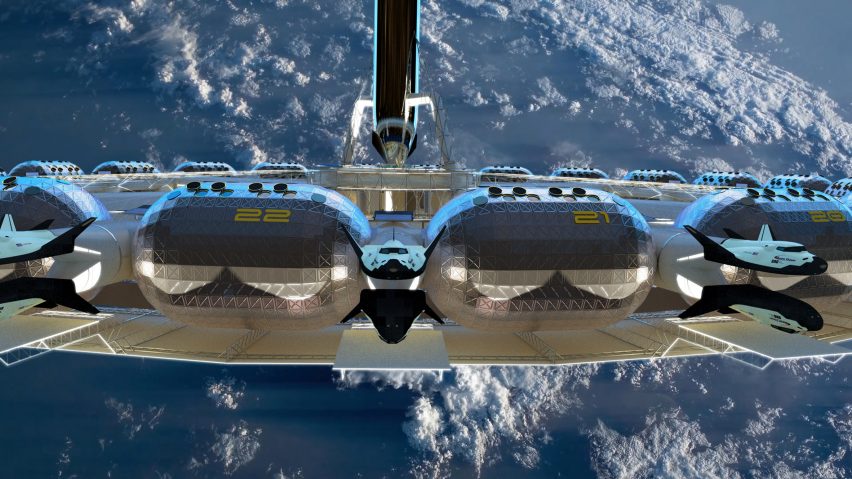
Visiting space will be "just like going on a cruise" says space hotel architect
The first commercial space hotel will be more like a cruise ship than Stanley Kubrick's sleek space station from 2001, says Tim Alatorre, senior design architect of the Von Braun Space Station.
The Gateway Foundation is designing the world's first space hotel – the Von Braun Space Station – with the aim of making visiting space accessible to everyone.
It will have gravity, full-working kitchens, bars, and interiors made with natural materials and colours.
"Eventually, going to space will just be another option people will pick for their vacation, just like going on a cruise, or going to Disney World," Alatorre told Dezeen.
"The goal of the Gateway Foundation is to have the Von Braun operational by 2025 with 100 tourists visiting the station per week, he continued.
"Because the overall costs are still so high most people assume that space tourism will only be available to the super rich, and while I think this will be true for the next several years, the Gateway Foundation has a goal of making space travel open to everyone."
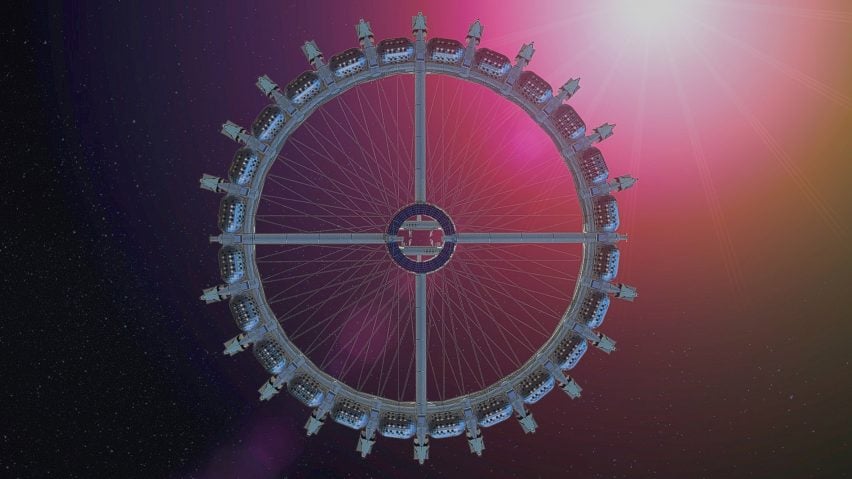
The Von Braun Space Station will build on technology used at the current International Space Station (ISS), however, unlike its predecessor the space hotel will have artificial gravity making both visiting and long-term habitation much more comfortable.
The design is based on concepts developed in the 1950s by Wernher von Braun – after whom the hotel is named.
The station will consist of a 190-metre-diameter wheel that will rotate to create a gravitational force similar to that felt on the moon. Around the wheel will be 24 individual modules fitted out with sleeping accommodation and other support functions.
"There will also be many of the things you see on cruise ships: restaurants, bars, musical concerts, movie screenings, and educational seminars," explained Alatorre.
Some modules will be sold as private residences, while others will be rented to governments for scientific purposes. In total the Gateway Foundation expect the population of the station to be around 400.
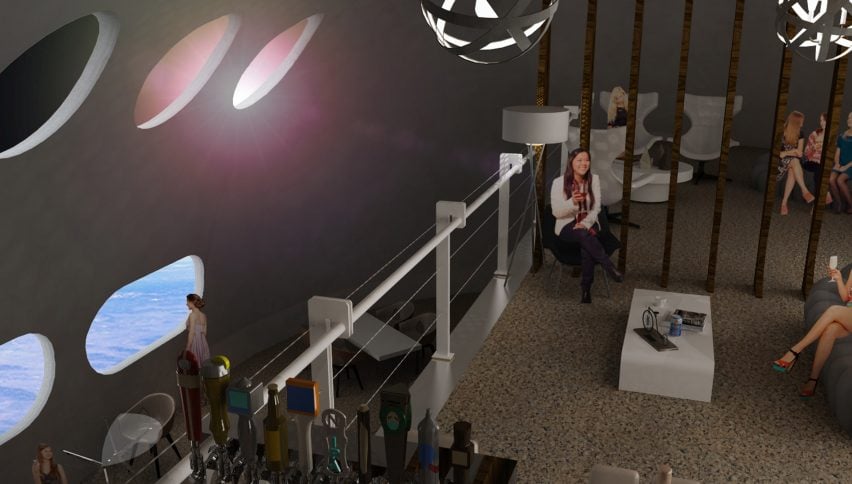
The Gateway Foundation want visits to the space hotel to be comfortable and intend to reject the sleek futurist interiors often seen in movies in favour of more familiar decor.
"In the movie 2001: A Space Odyssey, Stanley Kubrick's Space Station 5 is a sterile, white, museum-like hotel," explained Alatorre.
"While it made for a clearly futuristic feeling in the movie, in reality, it wasn't a very inviting space. As humans, we innately connect to natural materials and colours."
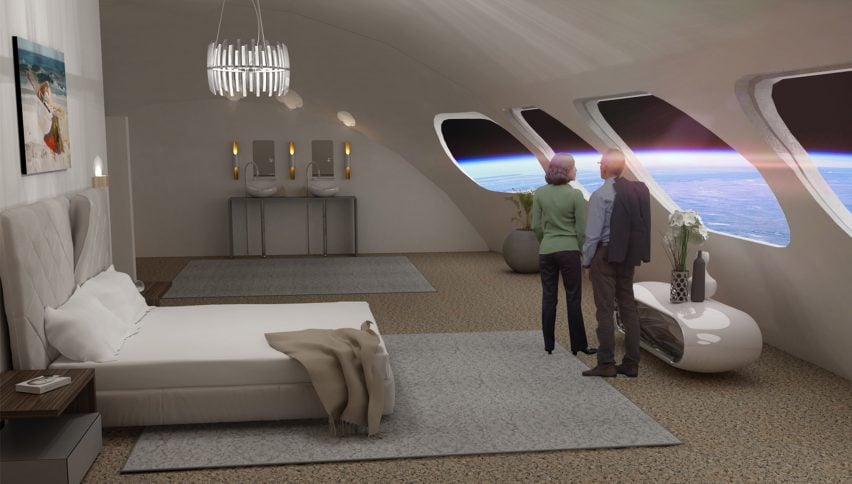
The interiors will make use of natural materials to give visitors to the space hotel a comfortable, homely experience.
"Developments in material science now allow for lightweight, easily cleanable natural material substitutes for stone and wood that would normally not be feasible to bring into orbit," said Alatorre.
"The use of fabrics, warm-coloured lighting and paints, and materials with texture, all help us to connect and feel at home. Because the station will have gravity there will be sense of direction and orientation that isn't present in the ISS."
The presence of gravity means that many issues experienced by astronauts on the ISS will not affect the Von Braun Space Station. Visitors will be able to go to the toilet in the normal way, showers will use recycled water, while food will be served in standard restaurants.
"We are planning on full-service kitchens with all of the dishes you would expect on a luxury cruise ship or in a major hotel," said Alatorre. "A lot of the logistical issues for food service have been worked out years ago by the cruise ship industry.
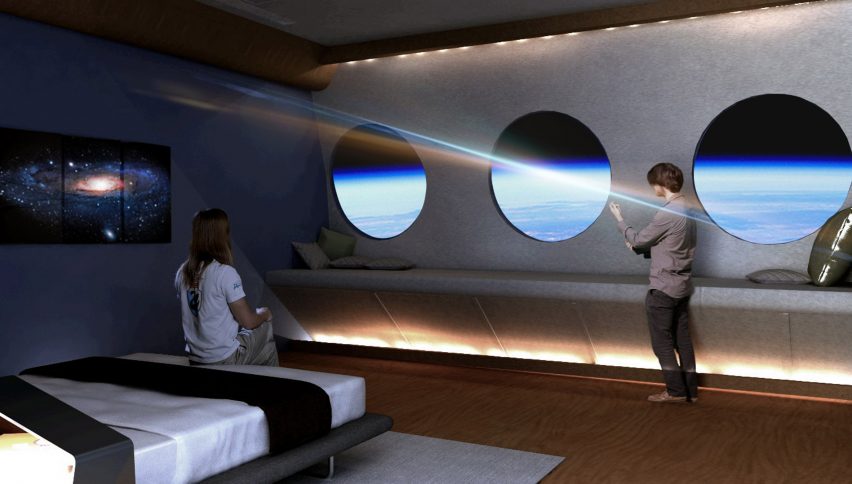
After the Von Braun Space Station has been built, the Gateway foundation intend on building an even larger space station to accommodate the growing demand for visits that they anticipate.
"Looking beyond 2030, the Von Braun Station is a proof of concept for the Gateway Foundation's next project which are a class of station called The Gateway, which will house over 1,400 people," explained Alatorre.
"These will be true cities in space that will be ports of call for those coming and going from the moon and Mars."
Read the full interview with Tim Alatorre below:
Tom Ravenscroft: What are the core principles behind the design of the Von Braun Space Station?
Tim Alatorre: As a species we have had a transient and limited presence in space by a small number of specialists for over 58 years. We want to change that and open up space to anyone who wishes to work or live in space. At the core of this project is the goal of forming a space construction industry to accelerate the permanent habitation of space and throughout the solar system. To that end the team behind The Gateway Foundation first incorporated a space construction company called Orbital Assembly.
The main objective for the Von Braun Station is to be the first space station to have artificial gravity. Astronaut Scott Kelly's recent year-long stay on the International Space Station made clear that long term habitation of space in micro-gravity is not sustainable. The dream of the Gateway Foundation is to create starship culture, where there is a permanent community of space-faring people living and working in Earth's orbit and beyond.
The station is designed to address the medical challenges of micro-gravity by simulating lunar gravity, and provide for all the comforts of life including recreation areas, restaurants, bars, and water, air and waste processing.
Tom Ravenscroft: What is the main inspiration for your space station?
Tim Alatorre: The main design inspiration for the space station are the station concepts developed by Wernher von Braun in the 1950s. He envisioned a rotating wheel with a diameter of 76 meters with three decks and revolving at three rpm and a crew of 80.
The Gateway Foundation put the name of the station up to a vote of its members earlier this year and it was overwhelmingly voted to be named after Von Braun. Our station also has three decks but a diameter of 190 meters allowing for a slower rotation rate that research shows is important for human comfort. Our new station is also planned to have a total population of 350 to 450 people, including over 100 crew.
Tom Ravenscroft: How does the design build on the design of the ISS?
Tim Alatorre: None of what we are proposing would be possible without the development and research done for the ISS. We are using current technology in all subsystems to minimise both cost and development schedule impacts.
The shielding technology, module designs, energy-management systems, water and air processing systems, as well as overall architecture are heavily influenced by the ISS.
Tom Ravenscroft: What are the main differences?
Tim Alatorre: One major difference between the Von Braun Station and the ISS is the way it will be constructed. The ISS was assembled in orbit using the manual labour of astronauts performing risky extra vehicular space walks. Although some large components of the Von Braun Station, such as the habitation modules, will be fabricated on Earth, the main structure will be primarily fabricated in space by automated and semi-autonomous systems.
Materials will be sent to orbit in much smaller component parts and then positioned, welded, and assembled using drones, robots, single-person pods, and a space construction machine being developed by Orbital Construction called the GSAL. This is actually the most important part, because we will learn how to build massive structures in space from what we learn building the Von Braun Station.
Tom Ravenscroft: How does your space station combine scientific and hotel functions?
Tim Alatorre: The Von Braun Station is designed with 24 modules, each with up to 500 square metres of floor area. Each of these modules will have a different dedicated function.
Several are dedicated to common areas such as the bars, restaurants, recreation areas, and mechanical systems. A few modules will be for the hotel functions and private residences. Other modules will be sold or rented to governments and scientific bodies for research and development.
Because each module is independent the station functions like a small community or business park, drawing on common resources while maintaining privacy and security. There has never been a low-gravity research facility in space so we feel the research component is critical. Likewise, allowing for true space tourism will make the station financially self-sufficient and drive innovation and public policy in ways never before seen. Both research and tourism are key to making long-term space habitation a reality.
Tom Ravenscroft: How do you intend on creating a home-like atmosphere at the space station hotel?
Tim Alatorre: In the movie 2001: A Space Odyssey, Stanley Kubrick's Space Station 5 is a sterile, white, museum-like hotel. While it made for a clearly futuristic feeling in the movie, in reality, it wasn't a very inviting space. As humans, we innately connect to natural materials and colours.
Developments in material science now allow for lightweight, easily cleanable natural material substitutes for stone and wood that would normally not be feasible to bring into orbit. The use of fabrics, warm-coloured lighting and paints, and materials with texture, all help us to connect and feel at home. Because the station will have gravity there will be sense of direction and orientation that isn't present in the ISS. Additional cues using lighting and materials will help to "ground" the occupants.
Tom Ravenscroft: What would people spend their time doing in the hotel?
Tim Alatorre: The majority of the station will initially have approximately a sixth of Earth's gravity and other parts will have near zero gravity. The opportunities for what can be done on the station are really exciting. We've thought of a number of things but we are sure that new sports, products and companies will be developed to allow for things we haven't dreamed of.
Some of the planned-for activities are playing in the zero-gravity central hub, low-gravity basketball, low-gravity trampolining and rock climbing.
Tom Spilker, the station's lead engineer, came up with a game that involves running all the way around the curved walls and ceiling of the gym. Also, there is potential for playing fictional games such as Quidditch from the Harry Potter series and the battle games from the Ender's Game series.
There will also be many of the things you see on cruise ships: restaurants, bars, musical concerts, movie screenings, and educational seminars. Eventually, we plan on offering excursions in true space ships (not designed to return to Earth) out to other stations or the moon.
Tom Ravenscroft: How would you serve food in the hotel? What about going to the toilet?
Tim Alatorre: The majority of food will be served in one of the two restaurants on the station. We are planning on full service kitchens with all of the dishes you would expect on a luxury cruise ship or in a major hotel. A lot of the logistical issues for food service have been worked out years ago by the cruise ship industry.
The primary challenge we have is dealing with the exhaust for cooking odours and smoke since we just can't vent them to the exterior like you would on Earth. Since we will have artificial gravity the toilets and restroom facilities will function almost identically to what people are used to on Earth.
Hotel visitors won't have to struggle with micro-gravity toilets and shower facilities like the astronauts use on the ISS. All drinking water will be brought directly from Earth, and non-potable uses like showers and toilets will use recycled water. There is no technical limitation to using recycled water for drinking, but it's a decision we made based on human psychology, the same approach used on the ISS.
Tom Ravenscroft: What is the future of space tourism?
Tim Alatorre: Space tourism and space habitation for the average person is on the brink of a major breakthrough. With the dramatic increase in private companies providing low-cost launch services to orbit and the overall commercialisation of space that is being pushed by NASA, there has never been a time in history where it has been more financially feasible to travel in space.
Because the overall costs are still so high most people assume that space tourism will only be available to the super rich, and while I think this will be true for the next several years, the Gateway Foundation has a goal of making space travel open to everyone.
They are developing programs that will give people with average incomes the ability to win or buy discounted tickets and spend a week in space. Eventually, going to space will just be another option people will pick for their vacation, just like going on a cruise, or going to Disney World.
Tom Ravenscroft: When will it become normal? How many people will be travelling to space for tourism in 2025? Or 2030?
Tim Alatorre: The next breakthrough needed to make space tourism normal is going to be a high capacity Earth-to-orbit launch vehicle.
The most likely vehicle to be operational in the near future is Space X's Starship and Super Heavy booster. It has a planned capacity of 100 people for journeys to Mars and up to 1,000 people for suborbital flights, although the final specifications are still to be released.
Elon Musk is hoping to get the Starship to orbit by the end of 2020 with crewed launches hopefully happening a couple of years after. Blue Origin is also making progress on their New Glenn heavy launch vehicle. These large capacity, reusable craft are important to keeping costs low. Virgin Galactic should be starting suborbital flights for a limited number of people within the year, being the first to market with commercial space tourism.
Their price per seat is still out of reach for most people but I'm fairly certain they have bigger plans in the works. Sierra Nevada corporation is also making significant progress with their Dream Chaser vehicle, which we are hoping to use as our "lifeboats".
The goal of the Gateway Foundation is to have the Von Braun operational by 2025 with 100 tourists visiting the station per week. By 2030 the goal is to have two stations in orbit with a population of at least 500 permanently living in orbit and 200 tourists per week, for a total of 10,000-plus people per year.
In addition to this, groups like the National Space Society and NASA have goals of their own. By 2030 we could have upwards of 1,000 people per month travelling into orbit, the moon and beyond. Predictions like these have been made in the past but all the pieces are finally coming together which are going to make this finally possible.
Looking beyond 2030, the Von Braun Station is a proof of concept for the Gateway Foundation's next project which are a class of station called The Gateway, which will house over 1,400 people. These will be true cities in space that will be ports of call for those coming and going from the moon and Mars.